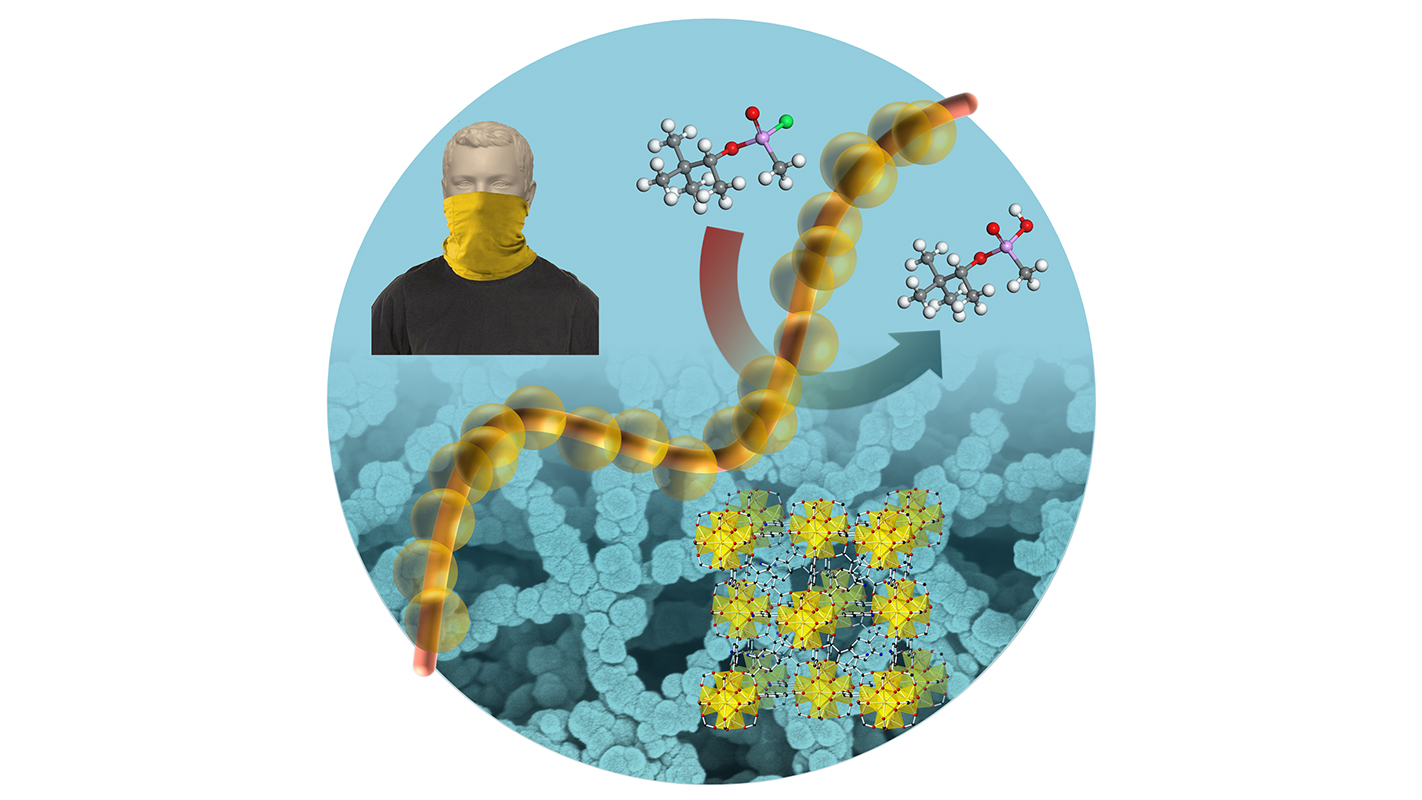For Immediate Release
Researchers have created a fabric material containing nanoscale fibers that are capable of degrading chemical warfare agents (CWAs). Uniform coatings of metal-organic frameworks (MOFs) were synthesized on top of the nanofibers, forming unique kebab-like structures. These MOFs are what break down the CWAs, rendering them harmless.
“Current technologies for addressing CWAs rely on carbon-based materials – but these carbon materials can only adsorb hazardous compounds, they can’t degrade them,” says Junjie Zhao, a former Ph.D. student at North Carolina State University and lead author of a paper on the work. “Our goal was to develop new materials that can detoxify these CWA compounds, and we’ve been successful.” The CWA degradation research was conducted by researchers in Gregory Parsons’ group at NC State, and co-workers at RTI International and the Edgewood Chemical Biological Center.
“Previous research had found that MOFs can be effective at degrading CWAs,” Zhao says. “However, MOFs normally come in the form of a powder. We wanted to see if we could grow MOFs as functional coatings onto fibers, so that they could be used in masks, filters and protective garments.”
“We think that this demonstration of well-controlled MOF thin films that retain their chemical functionality is an important step for personal security and has implications for many other civilian and commercial uses,” adds Parsons, who is Alcoa Professor of Chemical and Biomolecular Engineering at NC State.
The researchers begin by depositing a thin film of titanium oxide onto a fabric made of nanoscale fibers using a vapor-phase technology called atomic layer deposition. The titanium oxide serves as a nucleation layer, which enables the researchers to apply various zirconium-based MOFs onto the nanofibers in an evenly distributed way.
“We found that the MOFs formed on the nanofibers in a kebab-like structure, with the MOFs uniformly covering the entire nanofibers, like meatballs on a skewer,” Zhao says.
The researchers then tested the MOF-functionalized fabric against both a CWA simulant and the nerve agent soman. They found that, when exposed to the nano-kebab fabric, the half-life of the CWA simulant was as brief as 7.3 minutes. The half-life of the soman was as short as 2.3 minutes.
“This is a big step forward for materials designed for CWA protection” says Christopher Oldham, a senior research scholar at NC State and co-author of this paper. “The next steps include integration of the MOF-nanofiber kebab structures into currently fielded garment and suit materials, and evaluating the durability of the materials in various conditions. Currently, field chemical suits are heavy and require a lot of energy for the soldier to wear. If we can integrate the MOF-coated nanfibers into outer layers of the chemical suit, inner layers of the suit might be removed. Ultimately this may translate to a suit that potentially behaves and feels more like a piece of athletic wear than a garbage bag.”
The paper, “Ultra-Fast Degradation of Chemical Warfare Agents Using MOF–Nanofiber Kebabs,” is published in the journal Angewandte Chemie International Edition. Corresponding authors of the paper are Parsons and Gregory Peterson of the Edgewood Chemical Biological Center. The paper was co-authored by Dennis T. Lee, Heather F. Barton, and Ian R. Woodward of NC State; Robert Yaga and Howard Walls of RTI; and Morgan Hall of Edgewood. The work was done with support from Edgewood, under grant number W911SR-07-C-0075, and the U.S. Army Research Office, under grant number W911NF-13-1-0173.
-shipman-
Note to Editors: The study abstract follows.
“Ultra-Fast Degradation of Chemical Warfare Agents Using MOF–Nanofiber Kebabs”
Authors: Junjie Zhao, Dennis T. Lee, Heather F. Barton, Ian R. Woodward, Christopher J. Oldham, and Gregory N. Parsons, North Carolina State University; Robert W. Yaga and Howard J. Walls, RTI International; Morgan G. Hall and Gregory W. Peterson, Edgewood Chemical Biological Center
Published: Sept. 21, Angewandte Chemie International Edition
DOI: 10.1002/anie.201606656
Abstract: The threat associated with chemical warfare agents (CWAs) motivates the development of new materials to provide enhanced protection with a reduced burden. Metal–organic frame-works (MOFs) have recently been shown as highly effective catalysts for detoxifying CWAs, but challenges still remain for integrating MOFs into functional filter media and/or protective garments. Herein, we report a series of MOF–nanofiber kebab structures for fast degradation of CWAs. We found TiO2 coatings deposited via atomic layer deposition (ALD) onto polyamide-6 nanofibers enable the formation of conformal Zr-based MOF thin films including UiO-66, UiO-66-NH2, and UiO-67. Cross-sectional TEM images show that these MOF crystals nucleate and grow directly on and around the nanofibers, with strong attachment to the substrates. These MOF-functionalized nanofibers exhibit excellent reactivity for detoxifying CWAs. The half-lives of a CWA simulant compound and nerve agent soman (GD) are as short as 7.3?min and 2.3?min, respectively. These results therefore provide the earliest report of MOF–nanofiber textile composites capable of ultra-fast degradation of CWAs.
- Categories:



